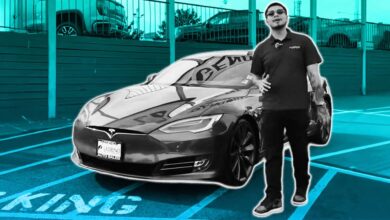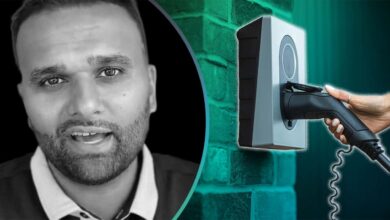Congress Killed The Law That Saved You Money At The Pump. What Now?

The soon-to-be-dead electric-vehicle federal tax credit program for consumers wasn’t the only policy that supercharged EV sales in the U.S. Another critical piece of legislation—one aimed at improving fuel economy and saving you money at the pump—was quietly accelerating America’s shift toward electrification and away from gas-guzzlers.
Now, that law has been rendered obsolete by Congress. So, what does this mean for you? And how does it impact the automakers’ plans?
Changes To Fuel Economy Rules, Explained
The National Highway Traffic Safety Administration (NHTSA) has long required automakers to comply with the Corporate Average Fuel Economy (CAFE) standards. That means across their fleets, carmakers had to meet minimum average fuel economy targets.
However, the Trump administration’s recently passed One Big Beautiful Bill rendered those standards effectively powerless, slashing penalties for non-compliance down to $0.

Experts say polluters now get a free pass for polluting. Legacy automakers may continue producing gas guzzlers as long as the penalties remain $0. But it won’t impact vehicle emissions and fuel economy in the short term. Cars on the market today were designed years ago and were engineered to comply.
Still, there’s little reason to cheer the nullification of CAFE.
“Essentially, having any regulation without penalties, it stops being a regulation,” Aleksandra O’Donovan, the head of electrified transport at research firm BloombergNEF, told InsideEVs. “If you don’t have to do it, you won’t be doing it,” she said, referring to the CAFE requirements to hit a certain fuel economy target.
“It’s still cheaper for them [to make gas cars] and they’re much more optimized for manufacturing combustion vehicles,” O’Donovan added.
The CAFE standards were signed into law by Congress in 1975 during the oil crisis to reduce the country’s reliance on fossil fuels. Having existed for half a century, the rules gave birth to a new age of cars that sipped gas instead of gulping it. They also encouraged automakers to develop more efficient combustion engines, which triggered the rise of hybrids, starting with the Toyota Prius in the 1990s.
Over time, those rules have gotten increasingly tougher. And that has made them massively unpopular among many carmakers.

Photo by: Toyota
To comply, automakers had to meet fleet-wide average fuel economy targets, which went higher and higher over the years. Selling more EVs is the most cost-effective and efficient way to increase compliance and reduce the amount of fines they would be subjected to.
The current target for model year 2025 vehicles is 53.4 miles per gallon (mpg) for passenger cars and 38.2 mpg for light-duty trucks. For model years 2027 to 2031, the targets would increase 2% each year and reach 65 mpg for passenger cars and 45.2 mpg for light-duty trucks by 2031—a stricter rule finalized by the Biden administration last year.
That’s a tough target to meet. This is why so many automakers started pivoting to EVs: If they had vehicles with much higher miles-per-gallon equivalents (the esoteric MPGe rating you often see on EV price labels) then that would help them meet or exceed those goals. In some instances, this is where the false perception of an “EV mandate” came from—the idea that automakers would have no choice but to sell EVs to meet CAFE rules.
Non-compliance translates into millions of dollars in penalties, which is why traditional automakers have opposed CAFE standards. Stellantis paid $235.5 million in penalties for model year 2018 and 2019 vehicles. General Motors paid $128.2 million in fines for model year 2016 and 2017 vehicles.
If the 2027-2031 rules were unchanged, automakers would have had to collectively cough up $14 billion for non-compliance, according to the Alliance for Automotive Innovation, a trade group representing major automakers in the U.S., including GM and Toyota. These penalties, coupled with the increased R&D costs needed to make cleaner cars, is why automakers often pushed back on CAFE rules.
CAFE Rules Save You A Lot Of Cash
The thing is, the CAFE rules save everyday drivers a serious amount of money at the pump. More efficient cars have driven savings between a few hundred and thousands of dollars over the lifespan of a vehicle, depending on which estimate you look at.
According to a 2013 Consumer Reports study, CAFE rules for model year 2017-2025 vehicles saved owners an average of $4,500 in fuel savings over the lifetime of their vehicle. The 2027-2031 estimates are more modest, with fuel savings of $600 to $700 over the lifespan of a vehicle, according to the NHTSA.
EVs allow even greater savings as owners forego “fuel” entirely. Fast-charging may be on the expensive side, but residential electricity for home charging is never on par with gas costs. In fact, EnergyInnovation.org has an excellent tool that helps you compare the cost of refueling a gas car compared to fully recharging an EV.
For example, a Toyota Camry in Texas costs double to refuel compared to a Tesla Model 3 to drive a similar number of miles.
What The Automakers Are Saying
But after the One Big Beautiful Bill passed, the Alliance celebrated the Trump administration’s decision to nullify the penalties.
“CAFE’s a relic of the 1970s—a policy to promote energy conservation and energy independence by making internal combustion vehicles more efficient,” John Bozzella, the president of Alliance for Automotive Innovation, said in a statement. “Those fines wouldn’t have produced any environmental benefits or additional fuel economy and would’ve foolishly diverted automaker capital away from the massive investments required by the EV transition.”
Since the budget reconciliation bill could only include items related to spending, it did not have the majority needed in Congress (60 votes) to revoke the CAFE standards altogether. Under Senate rules, however, lawmakers could modify the penalties, which is exactly what they did.
That prompted environmental organizations to warn that if automakers aren’t held accountable for the pollution caused by their vehicles, they’ll have no reason or motivation to continue making fuel-efficient cars or EVs.

Photo by: Ford
“For decades, CAFE has pushed manufacturers to deliver cleaner, more fuel-efficient vehicles, translating to drivers paying less at the pump,” Katherine Garcia, the director of the Sierra Club’s Clean Transportation For All campaign, told InsideEVs.
“Gutting CAFE penalties means automakers receive no retribution for violating fuel economy standards,” she added. “It’s a win for polluters and a loss for anyone who drives and cares about fuel savings and clean air.”
An End To Cleaner Cars? Not Really
Yet, it seems unlikely that automakers would suddenly stop making fuel-efficient cars. If their customers have to pay more to refuel, they could risk losing them to rival brands that fare better on that front.
Plus, automakers don’t plan in four-year cycles depending on who’s in the White House. They plan decades in advance to stay ahead of the curve. A future president might reinstate the penalties and try to put the EV movement back on track.
Above all, automakers are global companies with interconnected supply chains. Fuel efficiency rules are still effective in Europe, China and other major car markets. It’s hard to envision a scenario where they sell inefficient cars in the U.S. and still comply with European standards with models riding on similar platforms.
And finally, they still need to comply with the Environmental Protection Agency’s emissions standards, which also require automakers to produce fuel-efficient cars by restricting the harmful gases that their tailpipes emit. (At the same time, the EPA under Trump is planning to loosen the emissions regulations, though that process could take months—if not years.)
That’s why analysts are still cautiously optimistic about the growth of EVs in the U.S., even if things look bleak in the short term. BloombergNEF has dramatically reduced its forecast for EV adoption in the U.S.—from 48% of new car sales by 2030 to just 27%—but it still expects the broader industry to continue growing.
“In our 2025 forecast, we’re seeing that the [EV adoption] leaders will be China, Europe, Australia, South Korea, Canada, and then you have the U.S, which is kind of trailing below that global average line,” O’Donovan said. “It’s really left behind, and there’s really no way for the U.S to catch up with China or Europe at this point.”
Still, she added that the U.S. is far from being an ICE-only country. “On the global scale and in the longer term, it’s quite obvious that this is where the industry is going,” she said.
“If you stop investing in the space completely, you stop being competitive,” she added.
Have a tip? Contact the author: suvrat.kothari@insideevs.com
Source link



